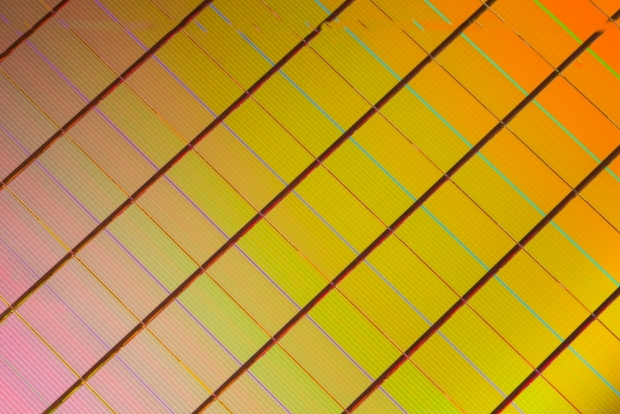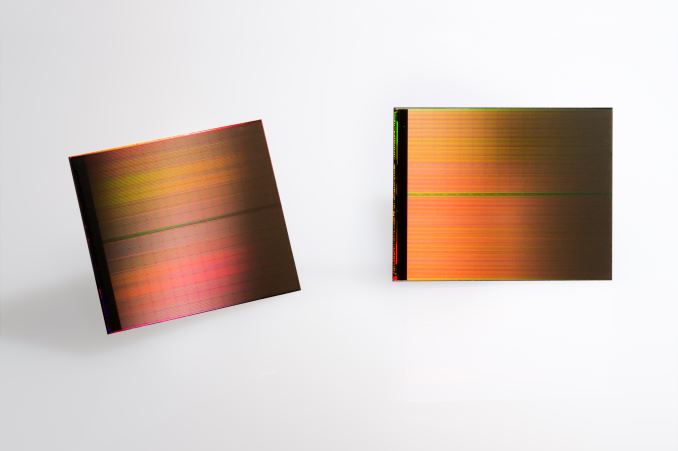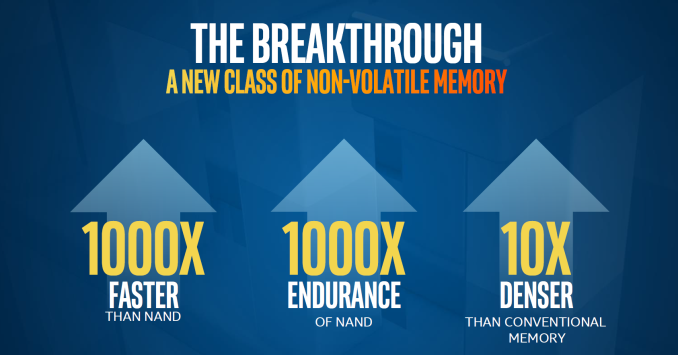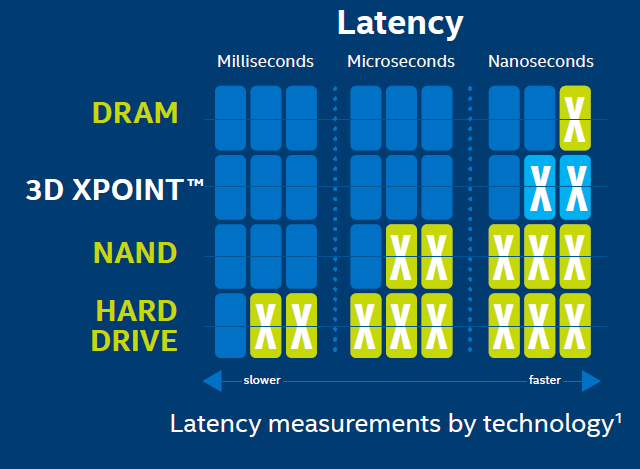Intel, Micron introduce revolutionary 3D XPoint memoryNoticia:At a special presentation today, Intel and Micron jointly announced the introduction of a new type of memory technology called 3D XPoint. Intel VP Rob Crooke and Micron president Rob Adams called this memory the first major new memory technology since the introduction of NAND in 1989.
3D XPoint (pronounced "3D cross-point") is described as a high-performance, very dense, non-volatile memory, and it's meant to help computers get more data closer to the processor. Crooke says it's a thousand times faster than today's flash memory and a thousand times more durable. Compared to DRAM, 3D XPoint is ten times as dense, and it's non-volatile. The initial 3D XPoint memory chips pack 128Gb on each chip, and that number is expected to increase as more layers are stacked on each chip.
The structure of 3D XPoint is a stack of individually accessible cells, between bit lines and word lines, combined with a switching system to manage storage and retrieval. Unlike current memory technologies, 3D XPoint doesn't store information by trapping electrons. Instead, it uses a property change of the memory cell materials itself. Furthermore, this property change uses all of the memory cell material. These innovations allow the memory cells to be shorter, packed tighter, and ultimately stacked higher, increasing density. Intel also says the cross-point architecture allows smaller amounts of data to be written or read in each transaction than is common with NAND. This capability could allow for faster, more efficient I/O.
Intel and Micron anticipate that the new tech will enable advancements in high-performance computing and big-data-crunching applications, where large amounts of high-speed storage close to the CPU ought to be very useful. We suspect that 3D XPoint's non-volatility and DRAM-like speed could allow it to replace DRAM in mobile devices, where the power savings offered by non-volatile memory could make for longer battery life.
Both firms are developing products based on 3D XPoint, and the memory will begin sampling "with select customers" later this year.
http://techreport.com/news/28712/int...-xpoint-memory
Parece ser uma tecnologia promissora e com tudo para dar certo.
User Tag List
 Likes: 0
Likes: 0
Resultados 1 a 4 de 4
Tópico: 3D XPoint memory
-
28-07-15, 17:26 #1Tech Ubër-Dominus


- Registo
- Nov 2013
- Local
- City 17
- Posts
- 30,121
- Likes (Dados)
- 0
- Likes (Recebidos)
- 2
- Avaliação
- 1 (100%)
- Mentioned
- 0 Post(s)
- Tagged
- 0 Thread(s)
3D XPoint memory
-
28-07-15, 17:30 #2Tech Ubër-Dominus


- Registo
- Nov 2013
- Local
- City 17
- Posts
- 30,121
- Likes (Dados)
- 0
- Likes (Recebidos)
- 2
- Avaliação
- 1 (100%)
- Mentioned
- 0 Post(s)
- Tagged
- 0 Thread(s)
Intel / Micron Live Reporting - 3D XPoint Memory
Noticia:Intel Corporation and Micron Technology, Inc. today unveiled 3D XPoint™ technology, a non-volatile memory that has the potential to revolutionize any device, application or service that benefits from fast access to large sets of data. Now in production, 3D XPoint technology is a major breakthrough in memory process technology.
Intel and Micron unveil 3D Xpoint™ technology and create the first new memory category in more than 25 years.



From Intel:
SANTA CLARA, Calif., and BOISE, Idaho, July 28, 2015 – Intel Corporation and Micron Technology, Inc. today unveiled 3D XPoint™ technology, a non-volatile memory that has the potential to revolutionize any device, application or service that benefits from fast access to large sets of data. Now in production, 3D XPoint technology is a major breakthrough in memory process technology and the first new memory category since the introduction of NAND flash in 1989.
The explosion of connected devices and digital services is generating massive amounts of new data. To make this data useful, it must be stored and analyzed very quickly, creating challenges for service providers and system builders who must balance cost, power and performance trade-offs when they design memory and storage solutions. 3D XPoint technology combines the performance, density, power, non-volatility and cost advantages of all available memory technologies on the market today. The technology is up to 1,000 times faster and has up to 1,000 times greater endurance3 than NAND, and is 10 times denser than conventional memory.
"For decades, the industry has searched for ways to reduce the lag time between the processor and data to allow much faster analysis," said Rob Crooke, senior vice president and general manager of Intel's Non-Volatile Memory Solutions Group. "This new class of non-volatile memory achieves this goal and brings game-changing performance to memory and storage solutions."
"One of the most significant hurdles in modern computing is the time it takes the processor to reach data on long-term storage," said Mark Adams, president of Micron. "This new class of non-volatile memory is a revolutionary technology that allows for quick access to enormous data sets and enables entirely new applications."
As the digital world quickly grows – from 4.4 zettabytes of digital data created in 2013 to an expected 44 zettabytes by 20204 – 3D XPoint technology can turn this immense amount of data into valuable information in nanoseconds. For example, retailers may use 3D XPoint technology to more quickly identify fraud detection patterns in financial transactions; healthcare researchers could process and analyze larger data sets in real time, accelerating complex tasks such as genetic analysis and disease tracking.
The performance benefits of 3D XPoint technology could also enhance the PC experience, allowing consumers to enjoy faster interactive social media and collaboration as well as more immersive gaming experiences. The non-volatile nature of the technology also makes it a great choice for a variety of low-latency storage applications since data is not erased when the device is powered off.
New Recipe, Architecture for Breakthrough Memory Technology
Following more than a decade of research and development, 3D XPoint technology was built from the ground up to address the need for non-volatile, high-performance, high-endurance and high-capacity storage and memory at an affordable cost. It ushers in a new class of non-volatile memory that significantly reduces latencies, allowing much more data to be stored close to the processor and accessed at speeds previously impossible for non-volatile storage.
The innovative, transistor-less cross point architecture creates a three-dimensional checkerboard where memory cells sit at the intersection of word lines and bit lines, allowing the cells to be addressed individually. As a result, data can be written and read in small sizes, leading to faster and more efficient read/write processes.
3D XPoint technology will sample later this year with select customers, and Intel and Micron are developing individual products based on the technology. (Editor's Note: It was mentioned that we will see this technology in the market place in 2016.)
Fun Facts: How Fast and Robust is 3D XPoint™ Technology?
July 28, 2015 — Technology, and memory technology in particular, can be overwhelming with so many
speeds and specifications to keep track of. 3D XPoint technology presents many potential advantages
for certain high-performance applications. The examples below help visualize these advantages in a
more abstract way, using examples from daily life.
3D XPoint Technology Performance
3D XPoint technology is up to 1,000xi faster than NAND.
o The average daily commute of Americans would reduce from 25 minutes in traffic to 1.5 seconds.ii
o Traveling by plane from San Francisco to Beijing could happen in about 43 seconds, instead of the 12 hours it takes now.
o The Great Wall of China could have been built in 73 days instead of 200 years.
HDD latency is measured in milliseconds, NAND latency is measured in microseconds, and 3D XPoint technology latency is measured in nanoseconds (one-billionth of a second).
In the time it takes an HDD to sprint the length of a basketball court, NAND could finish a marathon, and 3D XPoint technology could nearly circle the globe.
If computer storage were modes of travel:
o HDDs could take you from New York to Los Angeles by car in 4 days (2,500 miles).
o SSDs could get you to the moon in the same amount time (240,000 miles).
o 3D XPoint technology could get you to Mars and back in the same time (280 million miles).
3D XPoint Technology Endurance
3D XPoint technology has up to 1,000x the endurance of NAND.
o If 3D XPoint technology were your car’s engine oil, you would need an oil change a lot less often: once every 3,000,000 miles – the equivalent of driving around the world at the equator 120 times, or close to once around the sun.
o If your car got 1000x the gas mileage, the average driver would fill up once every 25 years.
A consumer-grade SSD can write 40 gigabytes per dayiv—enough to write 8.6 copies of the Encyclopedia Britannicav or 10,000 MP3 filesvi to the drive, every day for five years.
o An SSD with up to 1,000x increase in endurance could write the entire printed collection
of the U.S. Library of Congress (20TBvii) twice every day. After five years, that’s the
equivalent of 1.46 billion standard four-drawer file cabinets full of text or 73 petabytes.
Intel's page on 3D XPoint is now live.
http://www.hardocp.com/article/2015/...y#.Vbe7__n0OTQ
Mais pormenores sobre esta tecnologia.
-
30-07-15, 13:28 #3Tech Ubër-Dominus


- Registo
- Nov 2013
- Local
- City 17
- Posts
- 30,121
- Likes (Dados)
- 0
- Likes (Recebidos)
- 2
- Avaliação
- 1 (100%)
- Mentioned
- 0 Post(s)
- Tagged
- 0 Thread(s)
3D Xpoint memory uses 20nm process
Noticia:
Intel confirms
Earlier this wee, Intel and Micron announced a new memory that is 1,000 times faster than 3D NAND.
3D Xpoint memory doesn’t use transistors and it is made out of some secret material the company didn’t want to talk about. Luckily for us, we had Ken Furnanz, manager of business development non-volatile memory group at EMEA who was willing to answer some questions. According the CEO from Micron, this memory is so cool that people thoughz it is impossible to make.
We learned that the 3D Xpoint memory is going to be manufactured in Lehi, Utah, in a IM Flash factory but Ken told us it will be manufactured at 20nm process. Many have assumed that Intel and Micron will use 16nm NAND process but since this is not NAND memory, Intel and Micron chose to do it in 20nm.
With the 20nm manufacturing process they can manufacture 128 Gbit chips (16GB per die) which is on par with Micron MLC 16nm NAND that can provide the same 128Gb MLC device (16GB per die).
The way how it works is the cell that replaces the transistor will change its property and be able to store the data. Clearly this new material can do this really fast.
We also head repeatedly that the products based on 3D Xpoint memory should fill the gap between DRAM devices, that are fast and cannot store data, and NAND devices that are not fast enough, but can store the data once they power down.
We also learned that 20nm manufacturing is just the beginning, and, of course, the memory will eventually will shrink down to 16nm and beyond, and it can also expand adding multiple layers. After all, it is 3D Cross point memory so it can increase its capacity per die in many dimensions.
Ken didn’t want to go into product specifics and just confirmed the samples are shipping this year and products from separately Intel and Micron are expected next year.
http://www.fudzilla.com/news/memory/...s-20nm-process
-
31-07-15, 17:36 #4Tech Ubër-Dominus


- Registo
- Nov 2013
- Local
- City 17
- Posts
- 30,121
- Likes (Dados)
- 0
- Likes (Recebidos)
- 2
- Avaliação
- 1 (100%)
- Mentioned
- 0 Post(s)
- Tagged
- 0 Thread(s)
Analyzing Intel-Micron 3D XPoint: The Next Generation Non-Volatile Memory
Toda a analise:
The current mainstream memory technologies, namely DRAM (quick memory accessed by the processor) and NAND (solid-state storage), have been around for decades. While the cell designs have evolved over the years to allow scaling to 20nm and below, the fundamental physics behind DRAM and NAND operation haven't changed a bit and both technologies have their unique technological limitations. DRAM offers nanosecond-level latency and unlimited endurance, but this comes at the cost of large cell size, cell volatility, and power consumption. Since DRAM cells need to be constantly refreshed, the cells don't retain data in an off state, requiring quite a bit of power and making DRAM unsuitable for permanent storage. NAND, on the other hand, has much higher latency (especially write operations) and has a limited number of write cycles, but the cells are non-volatile and the structure is much more efficient, enabling low cost and suitability for storage.
Combining DRAM and NAND at the system-level architecture provides the best of both worlds, which is why modern computers use DRAM as a memory/cache and NAND for storage. However, there's still a latency and capacity gap between DRAM and NAND, so the question arises: what if you were to combine the best of DRAM and NAND at the silicon level? The mission of next generation memory technology across the industry has been to develop a new type of memory that provides low latency and high endurance while offering a small and scalable cell size.
We have seen numerous startups, such as Crossbar and Nantero, discuss and demonstrate their next generation memory technologies, but we have yet to see the established DRAM and NAND vendors come out with their solutions. Intel and Micron are here to change that with the announcement of their new 3D XPoint (Cross Point) non-volatile memory technology this week.
First and foremost, Intel and Micron are making it clear that they are not positioning 3D XPoint as a replacement technology for either NAND or DRAM, and in that scale it has been talked about more in its applications nearer NAND than DRAM. It's supposed to complement both and provide a technology that sits in between the two by filling the latency and cost gap exists between DRAM and NAND. Basically, 3D XPoint is a new tier in the computer architecture because it can be used as either slower, non-volitile memory or much faster storage.
Intel and Micron are claiming that 3D XPoint provides up to a thousand times higher endurance than NAND. Assuming that the numbers are relative to modern (15-20nm) MLC NAND, the endurance should be in the order of a few million P/E cycles; though the marketing materials are claiming up to tens of millions of write cycles. If we assume 3 million write cycles (1000x of what modern MLC has), a 256GB 3D XPoint based drive would have a total write endurance of 768 petabytes. That's equivalent to 420TB per day for five years, or 4.9GB per second. For storage applications that currently rely on NAND, 3D XPoint will eliminate any potential endurance concerns, but it's not durable enough to challenge DRAM in that front since DRAM endurance is essentially infinite. Whether 3D XPoint provides enough endurance to replace DRAM ultimately depends on the application, but especially in certain enterprise workloads there's a need for DRAM.DRAM 3D XPoint NAND Endurance (P/E Cycles) 10^15 10^7 10^3 Read Latency Nanoseconds 10s of Nanoseconds ~100 Microseconds
3D XPoint latency should be in the order of 10s of nanoseconds, but the companies didn't specify whether this is read or write latency. Judging by the graphs provided by Intel, it seems to be read latency because NAND write latency would measured in milliseconds (typically 1-2ms for a full page write), whereas the graph puts NAND latency at tens of microseconds that is in line with NAND read latency. Write latency is likely higher than that, probably at least 100s of nanoseconds or even a few microseconds given Intel and Micron's claims of "up to 1000x faster than NAND", but what complicates things is that 3D XPoint is accessible at the bit-level whereas NAND is page-level, so comparing the latency of the two without extended context is quite difficult. In any case, 3D XPoint performance should be closer to DRAM than NAND, but since Intel and Micron aren't discussing any specific latencies yet it's too early to make any final conclusions.
Meanwhile unlike many next generation memory technologies out there at the moment, 3D XPoint is the furthest along and doesn't only exist on paper or in a lab. Intel and Micron are currently sampling the first generation die that is being produced at the companies' jointly owned fab in Lehi, Utah. The die is 128Gbit (16GB) in capacity, whereas the products that startup memory companies have in production are in the order of dozens of megabytes. The die is built on a 20nm node and consists of two layers, and in the future scaling will happen through both lithography shrinks and by increasing the number of layers.
The Utah fab has been producing 20nm NAND for now since Intel didn't invest on the 16nm shrink and all initial 3D NAND production will take place in Micron's Singapore fab, but it's unclear whether the full fab with its 20,000 wafers per month capacity will be dedicated to 3D XPoint from now on. My guess would be that 3D XPoint will gradually take over the full wafer capacity in Utah depending on how the market reacts to the new technology and how high demand Intel and Micron are seeing. 3D XPoint does require some new equipment for manufacturing since 3D XPoint deals with a whole new set of materials, but Intel and Micron said that the transition is quite similar to a new NAND node and allows some of the existing equipment to be used.
The companies aren't quoting any price per gigabyte yet, but since the whole function of 3D XPoint is to fill the gap between DRAM and NAND, it will also be priced accordingly. A quick look at NewEgg puts DRAM pricing at approximately $5-6 per gigabyte, whereas the high-end enterprise SSDs are in the range of $2-3. While client SSDs can be had for as low as $0.35, they aren't really a fair comparison because at least initially 3D XPoint will be aimed for enterprise applications. My educated guess is that the first 3D XPoint based products will be priced at about $4 per gigabyte, possibly even slightly lower depending on how DRAM and NAND pricess fall within a year.
http://www.anandtech.com/show/9470/i...ance-than-nand
Informação da Thread
Users Browsing this Thread
Estão neste momento 1 users a ver esta thread. (0 membros e 1 visitantes)







 Responder com Citação
Responder com Citação


Bookmarks